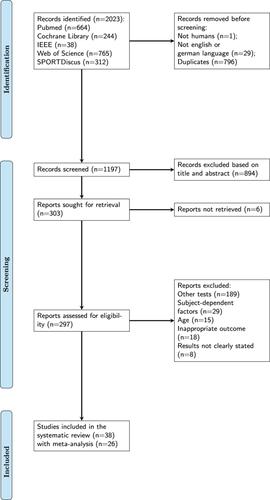Factors that influence the angular error in active knee angle reproduction tests: A systematic review and meta-analysis
Abstract
Purpose
The systematic review and meta-analysis investigated subject-independent test factors that influence the absolute angle error in active knee angle reproduction tests.
Methods
Five electronic databases were searched to identify relevant studies published before 20 December 2023. Studies were included that were published in either English or German and that investigated joint proprioception in the healthy knee. Included studies were also required to have participants 18–60 years old and free of lower-limb injury, neurological disorders and diseases affecting joint position sense. Risk of bias was assessed using a Cochrane risk-of-bias tool.
Results
Of the 2023 articles identified, 26 studies (1082 participants) were included in the meta-analysis. The meta-analysis showed a significant pooled standard mean difference in the absolute angular error for body orientation, direction of movement and fatigue. Active knee angle reproduction tests were found to have a lower absolute angular error when performed in the sitting position compared to the prone position (SMD = −0.56; 95% CI = −1.00 to −0.12). The absolute angular error was found to be greater in cases of knee flexion compared to knee extension (SMD = 0.71; 95% CI = 0.18–1.24). General and local muscle fatigue were found to result in a higher absolute angular error (SMD = 1.39; 95% CI = 1.04–1.75).
Conclusion
Hence, fatigue, body orientation and direction of movement influence the extent of the absolute angular error in active knee angle reproduction tests. Practitioners should be aware that the test conditions and the patient's level of fatigue can affect the results of such tests and that directly comparing results obtained using different test protocols may not be appropriate. The test protocol should be well documented and applied consistently in the clinical setting.
Level of Evidence
Level III, systematic review with meta-analysis.


 求助内容:
求助内容: 应助结果提醒方式:
应助结果提醒方式:


